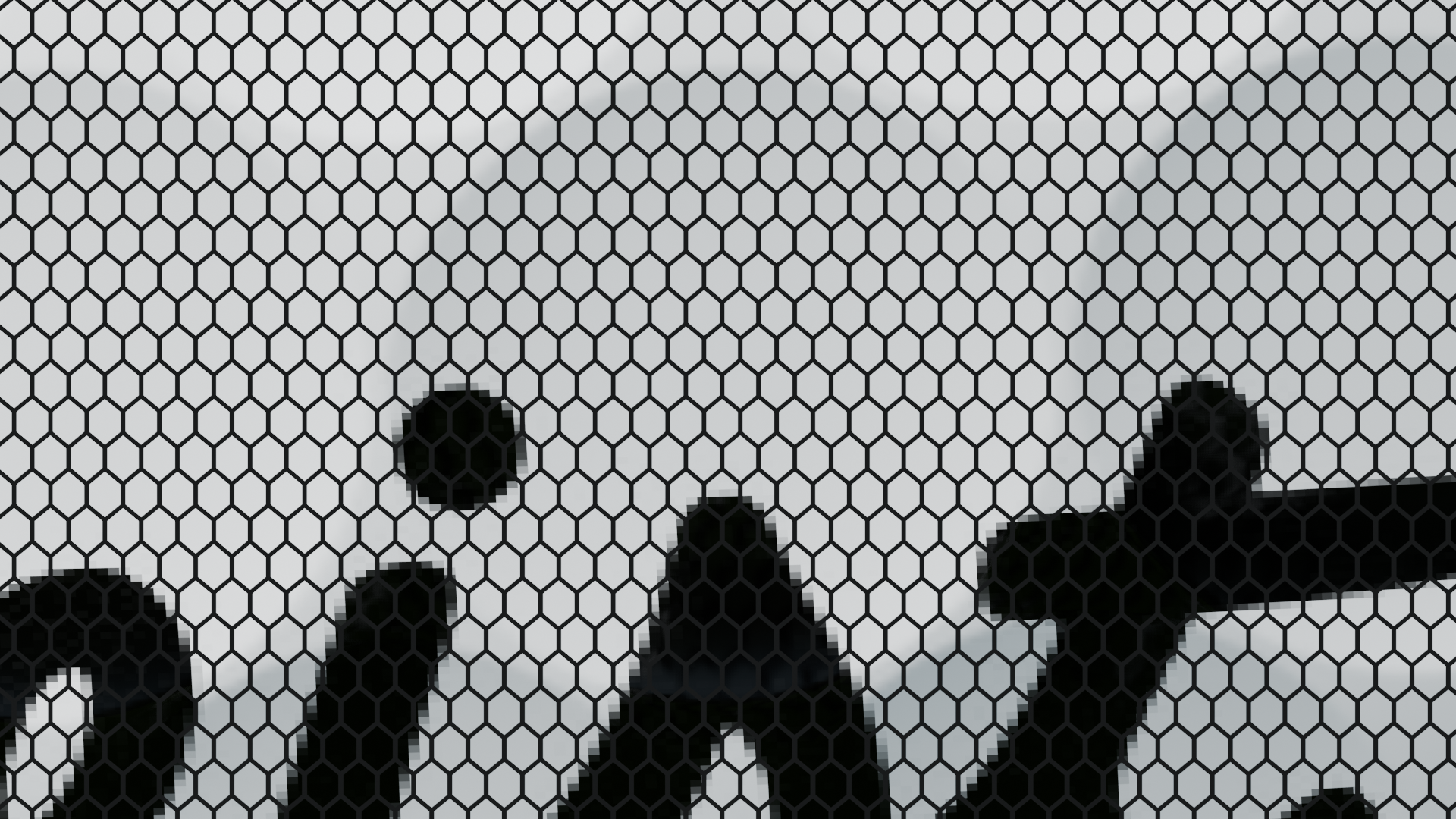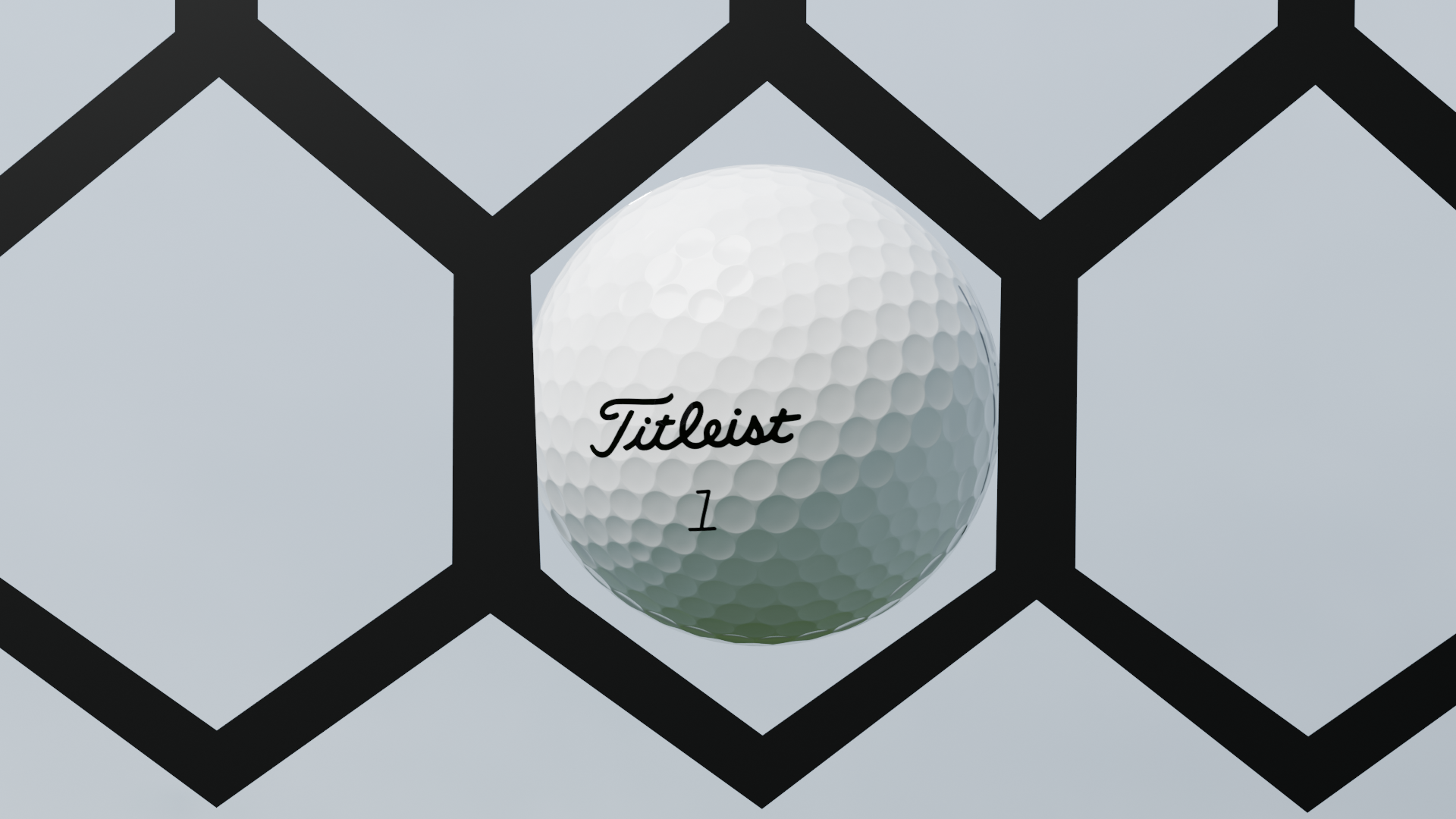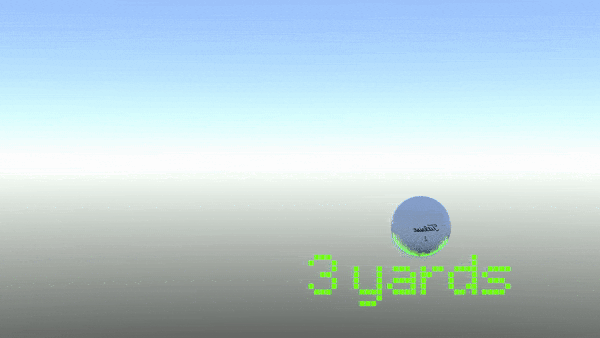How far away can a person see a golf ball?
“Did you see my ball?”
There are lots of reasons why a golf ball can seem to magically disappear, and I am familiar with most of them (sliced out of bounds, in deep weeds, under water, behind a tree, or in the sand). I guess in the hole is the other reason, but I wouldn’t know much about that one. However to what extent a persons eyesight factors into this (usually on the straight shots down the fairway), we first need to understand the variables at play, including the target size, resolution of the eye, visual processing and relative brightness, combined with a basic understanding of trigonometry.
Photoreceptors and Angular Resolution
The field of view of individual photoreceptors create a mosaic composed of hexagons, with each hexagon representing one photoreceptor. The 20/20 letters on a standard eye chart are always 5 arc minutes (5/60th of a degree) tall and wide, with spaces between parts of the letter being 1 arc minute in size. In the E for example, to tell its an E the viewer needs to be able to resolve the spacing between the arms of the E, which are the exact size of a photoreceptors field of view (1/60th of degree). Any error in focusing of the E will cause parts of it to fall on multiple different photoreceptors, making it appear washed out and blurry, making the viewer unable to tell what letter it is.
The human eye contains specialized cells called photoreceptors that allow us to perceive light. These photoreceptors come in two types: rods (responsible for low-light vision) and cones (responsible for color vision). When it comes to resolving fine details, cones play a crucial role and will be the focus of this discussion.
Angular Resolution: This term refers to the eye’s ability to distinguish between two closely spaced points. It’s like the “megapixels” of our vision. The smaller the angle, the better our ability to resolve fine details. The human visual field has been shown to be composed of millions of hexagon shaped “pixels” which represent the fields of view of each photoreceptor.
One Arc Minute Field: In a person with 20/20 eyesight, a single cone photoreceptor can be assumed to have an angular field of view of approximately 1 arc minute. This means it can distinguish two points separated by an angle of 1/60th of a degree. This concept is the basis of the standard eye chart, since the spaces in the big E are exactly 1 arc minute in size.
The Golf Ball
A golf ball at arms lengths will be detected by approx. 47000 different photoreceptors. Depending on your screens resolution, zooming in on this image will show the 47000 hexagon-shaped fields of these receptors. Each microscopic part of the ball’s surface will be the responsibility of a one particular photoreceptor. The sum of these parts will create a mosaic allowing the brain to detect that its a golf ball. Because so many photoreceptors are involved when looking at the ball at this distance, the ball looks very clear and detailed.
Now, let’s apply this knowledge to our golf ball. Working with arc minutes and degrees can seem somewhat abstract, so to help us get a better understanding of the scale we are working with, why don’t we start by figuring out how many photoreceptors are activated when the ball is held at arms length. We know that the diameter of a golf ball is 4.27 cm. When we hold the ball at a distance of 60 cm (arms length), we want to determine how many photoreceptors would be active when looking at it.
When the golf ball is held at arms length, discerning the dot on top of the ‘i’ in the word Titleist would be the responsibility of 8 different receptors.
Angular Size of the Golf Ball:
The angular size of the golf ball at 60cm can be calculated using basic trigonometry (which I wont go into here), and gives us 4°4'32" (4 degrees 4 arc minutes and 32 arc seconds).
Number of Photoreceptors:
Since we know that each photoreceptor has an angular field of 1/60th of degree, then if one was to draw a perfectly thin vertical line on the ball, at 60cm that line would activate approx. 244 photoreceptors (4 degrees * 60 photoreceptors/degree + 4/60 degrees * 60 photoreceptors/degree). Extrapolating that for the area of the circle that the ball subtends at 60cm, then we can determine that 46759 photoreceptors (per eye) are being simultaneously activated at arms length to see the entire ball, with the dot in the “i” for Titleist garnering the attention of 8 photoreceptors.
Extrapolating to One Photoreceptor
Now, let’s determine how far away the golf ball needs to be for the image of it to only activate one photoreceptor (per eye).
At a distance of 166.5 yards the golf ball will be the exact size of one photoreceptor’s field of view. As long as the golf ball has enough photons leaving it to excite that particular receptor relatively more than the adjacent receptors, the ball will be seen by the golfer, even if the ball is 200+ yards away and taking up only half of the receptors field of view.
Desired Angular Size:
We want the angular size of a 4.27cm diameter golf ball to be 1 arc minute (1/60th of a degree), since that’s the size that we have previously stated is the “field of view” of each photoreceptor in a person that can see 20/20. As previously shown, the angular size of a golf ball at arms length is 4°4'32".
Distance to Achieve One Photoreceptor:
Once again using trigonometry, we can now determine that a golf ball at 166.5 yards away will subtend an angle of 1/60th of degree, or the size of one photoreceptor.
Photoreceptors detection and vision
Now we know the distance at which only one photoreceptor will be detecting the ball, but what else is required for a person to see the ball? Surely there are scenarios where a person has seen their drive travel far past this distance, and others where a chip shot gets lost in the clouds.
Photons:
It can be hard to fully answer what the exact number of photons that are required to land on a single photoreceptor to flip the receptor from the “0 (I don’t see anything)” state to the “1 (I see something)” state, but some studies suggest this number is around 100 photons. So basically brightness matters.
Contrast:
If the ball is sending 100 photons towards a single photoreceptor in the eye, but the surrounding sky is also sending a 100 photons to every surrounding photoreceptor, it goes without saying that the ball will be invisible since every receptor in that region of the eye will be responding the same (“I see something”). In terms of detecting something in the visual field, the brain will only pick up on differences between a single photoreceptor and its adjacent surrounding photoreceptors and this difference appears to be relative. 100 photons from a dimly lit target in a completely black room can trigger the brain into determining one photoreceptor is significantly more active than its neighbors, but in a very bright room that same target will need to reflect/emit substantially more than 100 additional photons as compared to the background for it to be seen. Just like a person will notice if they have been overcharge by $1 on a cup of coffee, but will likely require that error to be closer to $100 for it to be noticed when buying a new car. This concept it termed the just noticeable difference. In terms of how this relates to the golf course, the bright white ball sitting on the dark fairway will be easier to detect than the same bright white ball traveling through an overcast sky.
Visual Potential:
Although I have repeatedly referenced the 1/60th degree field of view of a cone photoreceptor in a person with 20/20 vision, studies and clinical experience does suggest that there are photoreceptors in some people with an approx. 0.4/60th degree field of view, or 2.5x smaller than a person with 20/20 vision. For this type of vision to be achieved, the eye has to be almost perfect in terms of eye health, tear film, and no signs of even the earliest cataracts. In short, this is usually seen in younger people and they can occasionally see the 20/8 line on an eye chart. Interestingly enough some famous professional athletes have been known to achieve this level of visual acuity, which may be a blog post for another day.
Brain
Photoreceptors firing and others staying in the off position tells only part of the story. The brain takes a tremendous amount of varying visual input and past experiences before creating the images we seen, and numerous higher functioning parts of the visual system, including rapid eye movements and numerous specialized retinal cells contribute to the decision of “do I see the target”. For simplicity sake we will ignore most this in our calculations.
Refraction aka glasses/contact lenses/LASIK
In order for someone to achieve their visual potential (be it 20/20 or 20/8), the light from the target object (in this case the golf ball) has to stream towards the eyeball from the target at the speed of light, pass through the tear film, the cornea, the aqueous humor, the crystalline lens and the vitreous humor all while being condensed and focused (termed refracted) precisely onto the retina where the photoreceptors are found. If anywhere on this journey some photons go astray or get blocked, then the threshold of 100 photons landing on specific photoreceptor may not be met and the object will go unseen, or if there is a surplus of photons (ie the target is closer) they can begin to land on multiple photoreceptors leading to a blurry target. Some of these issues can be corrected with glasses or contact lenses or LASIK, especially in situations where the light is focusing properly (few stray or blocked photons), but instead is erroneously focusing in front of or behind the retina (analogues to a movie projector being too close or too far from the movie screen, which would have a simple fix).
So to answer our question, a golf ball of sufficient brightness relative to the surrounding sky needs to be approximately 166.5 yards away for the image of it to be detected by one and only one photoreceptor in a person with 20/20 vision. This same photoreceptor will continually fire as long as the minimum threshold of photons is reached, even if the ball is only taking up a fraction of the photoreceptor, which would happen at yardages greater than 166.5 yards. Its only when the brightness difference (photons) between the surrounding environment and the ball drops below a certain threshold that the ball will become invisible, which becomes exceedingly likely the further the ball travels (and therefore the smaller it gets) but can also happen at closer distances when the ball and sky have a similar degree of brightness (ie a chip shot into a cloudy sky). This is also why a golfer will lose the ball in the sky but pick it up again once it hits the fairway (this is the brightness difference/photons concept at play). In-office testing on a golf ball flight simulator that we created to test this concept shows that on normal, slightly overcast skies a person with 20/20 vision does indeed lose the golf ball midflight at around the 160 yard zone, however a person with 20/8 vision when tested with a bright white golf ball in a completely black surrounding environment track the ball 500+ yards.
In Conclusion (aka What to tell your friends on the golf course):
After 166.5 yards the golf ball is being tracked by only one photoreceptor in each eye, and will continue to track it if there is sufficient contrast between the ball and its surroundings.
To test contrast vision in office, we occasionally utilized a video that has been calibrate to represent the real-life size of the golf ball at various distances. Most patients when viewing an enlarged version of this video in 4k resolution from 20ft away will lose the ball at around 160 yards.
In very high contrast levels, some viewers can actually follow the golf ball to 500+ yards when the above video is enlarged and calibrate for a 20ft viewing distance.
Dr. Burke is an optometrist practicing at Calgary Vision Centre. Opinions above do not constitute medical advice, and readers should consult with their optometrist if they have questions or concerns about their eye health









